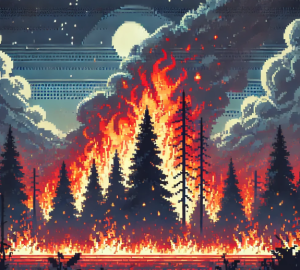
The Science Behind Spontaneous Human Combustion: Separating Fact from Fiction
What if a body could burst into flames without warning, leaving only ashes and a few intact limbs? Spontaneous Human Combustion (SHC) has fascinated and terrified people for centuries, often tied to tales of the supernatural.
But in the 21st century, science offers a more grounded—and equally intriguing—explanation. Let’s unravel the mystery and discover how science sheds light on this eerie phenomenon.
What Is Spontaneous Human Combustion?

SHC refers to cases where a human body is discovered with its torso and upper legs almost entirely reduced to ash, while the surroundings remain surprisingly undamaged. Historical accounts, such as the 1731 death of Countess Cornelia Baudi of Cesena, describe this unsettling pattern: intact legs but a body reduced to ashes, with no apparent source of ignition.
For centuries, SHC was attributed to supernatural forces, often used as cautionary tales about morality. Victims were depicted as elderly, overweight, or intemperate individuals, reinforcing stereotypes about societal “sins” like excessive drinking. However, modern investigations reveal a scientific process behind this rare event.
The Science of Combustion: The “Wick Effect”
The term “spontaneous” might be misleading—there’s nothing truly spontaneous about SHC. Instead, a sequence of events creates conditions for a “fat wick burn.” Here’s how it works:
- Source of Ignition: In nearly all modern SHC cases, an external ignition source (like a cigarette or match) plays a role. Even though it may burn away during the fire, it’s the spark that sets the stage.
- Melted Fat as Fuel: Once a person dies or becomes incapacitated, their body fat begins to melt. This fat saturates clothing, acting like the wick of a candle. The slow, sustained burn can reduce the torso to ash while sparing extremities.
- Localized Heat: Unlike raging house fires, these burns are relatively contained. Temperatures of 500–600°C (932–1112°F) are sufficient to incinerate soft tissues over hours without damaging the surrounding environment.
Debunking the Myths
Myth 1: Alcohol Makes the Body Flammable
While many SHC cases involve victims with high blood alcohol levels, alcohol does not make tissues inherently more flammable. Instead, intoxication may lead to accidents or a decreased ability to react to an ignited fire.
Myth 2: SHC Is Supernatural
Historical SHC accounts often leaned on mystical explanations, but science demonstrates that human fat, clothing, and ignition sources explain the phenomenon without invoking paranormal forces.
Myth 3: Bodies Can Completely Burn Spontaneously
Complete incineration of a human body requires extreme temperatures, such as those achieved in cremation furnaces. The “wick effect” explains partial incineration but not a truly spontaneous event.
Why Does SHC Appear So Rare?
SHC is often misrepresented due to its dramatic nature. Modern studies reviewed 12 cases between 2000 and 2011. These victims were typically alone, lived in confined spaces, and were often smokers—a combination of factors conducive to the “wick effect.” The rarity of such alignments makes SHC an uncommon occurrence.
Interestingly, the majority of reports hail from Europe, particularly France. Cultural or environmental factors might contribute to the clustering of cases, or it could simply be a matter of reporting bias.
Implications for Science and Safety
Understanding SHC sheds light on how the human body burns under specific conditions. This knowledge helps forensic scientists differentiate between accidental deaths, self-immolation, and potential foul play. It also provides fire safety insights, particularly in preventing similar tragedies.
For burn specialists, the study of SHC-like phenomena reveals the role of human fat as a fire accelerant, contributing to broader knowledge about fire dynamics and forensic pathology.
Let’s Explore Together
What do you think about the science behind spontaneous human combustion? Could understanding the “wick effect” help debunk other mysteries? Share your thoughts below!
- What other historical mysteries do you think could be explained by science?
- How do you think cultural narratives shape our understanding of rare events like SHC?
- Have you ever encountered an unexplained phenomenon that later had a scientific explanation?
Let’s keep the curiosity burning—join the conversation in the comments or on social media!
Explore and Learn with Science
Dive into groundbreaking research and inspiring stories with ‘This Week in Science’! Perfect for teachers and science enthusiasts, our free weekly newsletter expands your horizons in teaching and learning. Join us today and reshape your engagement with science. If you liked this blog, please share it! Your referrals help This Week in Science reach new readers.



